Baby, You Can Program My Car (Ep. 128)
Our latest Freakonomics Radio on Marketplace podcast is called “Baby, You Can Program My Car.” Yes, it’s about driverless vehicles. (You can download/subscribe at iTunes, get the RSS feed, listen via the media player above, or read the transcript here.)
I recently had the good fortune to go for a ridealong in a self-driving Cadillac SRX4 with three of the engineers responsible for making it go: Raj Rajkumar, John Dolan, and Jarrod Snider, all key players in the General Motors-Carnegie Mellon Autonomous Driving Collaborative Research Lab. We rode around a large track that the university has built on the site of an abandoned steel plant in Pittsburgh.
What was most remarkable, to me at least, was how unremarkable it felt to ride in a vehicle that no one was steering or braking. In other words, it felt normal — not like a science experiment or a rocket ride — and, as amazing a feat of engineering as a driverless car is, I also realized how much of the technology to go driverless already exists in the modern cars we’ve been driving for years (cameras, sensors, automation, etc.).




